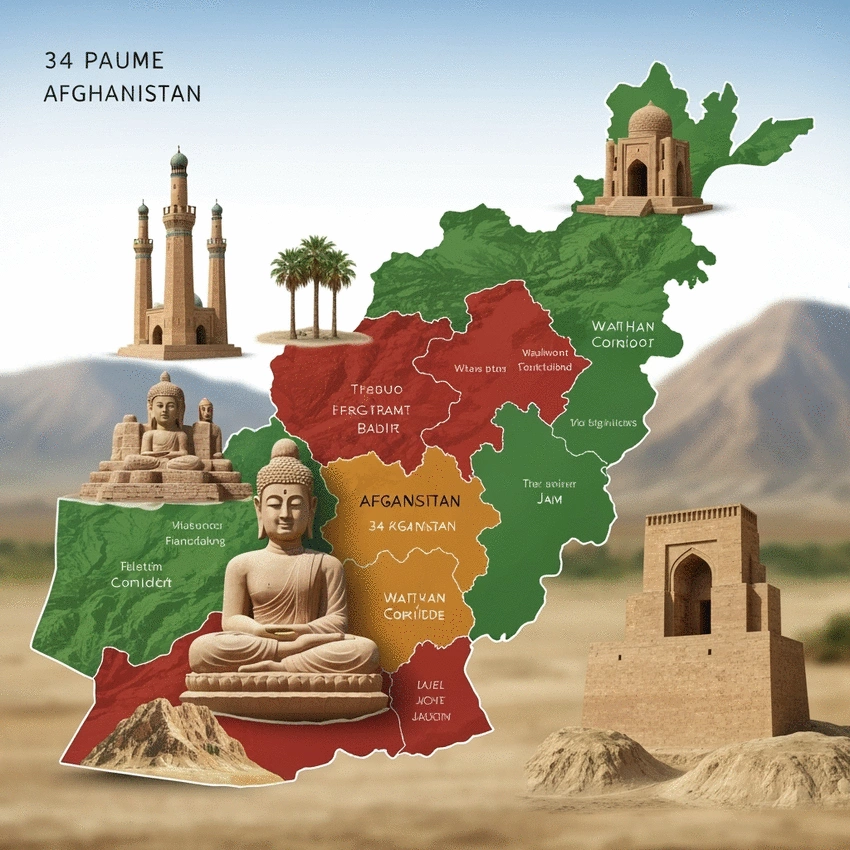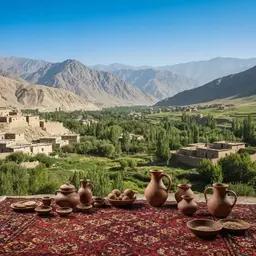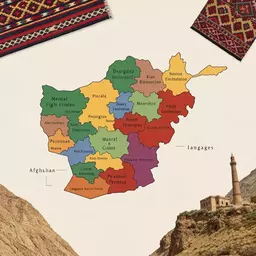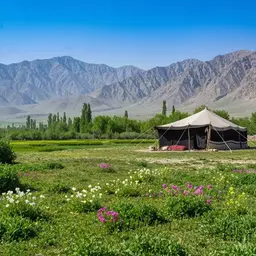Geography's Role in Afghan Culture
By Khalid Rahimi / Nov 19
As you prepare to explore the diverse landscapes of Afghanistan, consider this: every corner of the country tells a story, shaped by its geography, culture, and history. Understanding these elements can transform your experience from a simple visit into a rich journey of discovery.
This visual summarizes key characteristics of Afghanistan's provinces, highlighting their geographic features, administrative structures, and population demographics. Explore the diversity that shapes this unique nation.
Afghanistan is a land of stunning contrasts and profound beauty, with its 34 provinces each possessing unique characteristics that contribute to the country’s rich tapestry. In this section, we'll delve into the remarkable geographic landscape of Afghanistan, offering insights into its provinces and the intricate details that make each region special. For more in-depth information about the country's governance and human rights, you can refer to the 2023 Country Reports on Human Rights Practices for Afghanistan.
As we explore Afghanistan's geography, we’ll see how various elements—like topography, climate, and culture—intertwine to shape the lives of its people. Let's embark on this journey together and uncover the heart of what makes Afghanistan truly distinctive!
Afghanistan's provinces spread across a diverse landscape that includes rugged mountains, arid deserts, and lush valleys. Each province can be located on the map, revealing its geographical significance. It’s fascinating to see how geography influences not only the physical environment but also the lifestyle and traditions of the local communities.
Each province's location on the map is not just a point; it tells a story of historical trade routes, migrations, and cultural exchanges. The diversity in geography also leads to a variety of climatic conditions, which we’ll explore next.
Mapping Afghanistan's provinces provides a visual representation of its rich cultural landscape. From the high peaks of the Hindu Kush to the fertile plains in the south, the geographical diversity is astounding. Each province is interconnected, yet distinct, contributing to the nation's overall identity.
For instance, when looking at a map, you might notice how Herat serves as a gateway to the west, while Kandahar links to the south. Understanding these locations helps us appreciate the historical and cultural exchanges that have shaped Afghanistan over millennia. Further details on the country's origins and provincial dynamics can be found in the General Country of Origin Report Afghanistan (June 2023).
The topography of Afghanistan is dominated by mountainous areas, with more than 70% of the country being mountainous. This prominent feature significantly influences the climate and agricultural practices of its provinces. For example, the cooler climate in the north supports different types of crops compared to the warmer southern regions.
Through understanding these topographic features, we gain a deeper appreciation of how the Afghan people adapt their lifestyles and traditions to thrive in such a diverse environment.
Each province in Afghanistan boasts its own unique landscape and cultural significance. For instance, the breathtaking lakes of Band-e Amir in Bamyan province offer a striking contrast to the arid conditions found in the Helmand province. These geographical distinctions are pivotal in shaping local cultures and agricultural practices.
Additionally, provinces like Ghor are renowned for their rugged beauty and historical significance, where ancient structures stand testament to Afghanistan's rich heritage. Understanding these landscapes paves the way for a greater appreciation of the cultural narratives embedded within them. For specific information about the focus provinces, the EUAA's Country Guidance on Afghanistan 2023 provides valuable insights.
Turning our focus to the administrative framework, Afghanistan is divided into provinces, each functioning with a local government structure. This governance is essential for managing resources and addressing the needs of the population. By understanding how provinces are governed, we can better appreciate the complexities of Afghan society.
The governance of these provinces is critical, as it allows local leaders to respond to the unique challenges and aspirations of their communities, ensuring that the rich cultural heritage of each area is preserved and promoted.
Each province operates under a governor who oversees administrative functions and ensures local laws and regulations are upheld. This governance structure is vital for maintaining order and facilitating development across the provinces.
This collaborative approach helps bridge the gap between the government and local citizens, fostering a sense of ownership and responsibility among the people.
Understanding the key figures in each province provides a clearer picture of how governance functions in Afghanistan. Each province has its own set of administrative leaders, including the governor and heads of various departments.
These figures are pivotal in implementing policies that affect daily life, from education and health services to infrastructure and economic development. By recognizing their roles, we can appreciate the efforts being made to improve the lives of Afghan citizens.
The provincial capitals serve as the political and administrative hubs for their respective regions. Cities like Kabul and Herat not only function as centers of governance but also embody the cultural identities of their provinces.
In these capitals, governance meets culture, allowing for the convergence of tradition and modernity, which is vital for fostering a cohesive national identity.
When exploring Afghanistan's provinces, take the time to interact with local communities. Engaging with residents not only enriches your understanding of their culture but also allows you to hear firsthand the stories and traditions that are woven into the fabric of each region. Consider participating in community events or local markets to gain a deeper appreciation of the diverse lifestyles across the provinces.
As we wrap up our exploration of Afghanistan's provinces, it's essential to reflect on the unique experiences and insights that await those who venture into this captivating land. From the breathtaking landscapes to the rich cultural heritage, understanding Afghanistan’s provinces opens the door to a world of discovery. Whether you're a traveler, a researcher, or simply curious about this beautiful country, here’s what to expect.
When you set foot in Afghanistan, you’ll find a tapestry of experiences woven together by the diversity of its provinces. Each region boasts its own distinct character, shaped by geography, history, and culture. Here are some common questions that travelers and enthusiasts may have:
Addressing these questions can enrich your journey, ensuring a deeper connection with the land and its people. Additionally, understanding the demographics helps in appreciating the cultural dynamics of each province.
To grasp the full picture, it’s useful to consider the population statistics of Afghanistan’s provinces. The demographics reveal not only the number of inhabitants but also the ethnic diversity that contributes to the country's vibrant cultural landscape. Here are a few statistics that highlight this diversity:
Understanding these figures allows for a better appreciation of the cultural and social fabric that defines each province. It’s fascinating to see how geography and demographics are interwoven in the daily lives of Afghan communities.
Here are some common questions about Afghanistan's provinces to help deepen your understanding:
As you consider diving deeper into Afghanistan’s provinces, promoting informed exploration is crucial. It’s not just about visiting; it’s about learning and engaging with local communities. To assist you on this journey, here are some valuable resources:
These resources will enhance your understanding and appreciation of the complex narratives that unfold across Afghanistan’s provinces.
Supporting local communities during your travels goes a long way in promoting cultural preservation. Consider engaging with local artisans, participating in community-based tourism, or contributing to organizations dedicated to preserving Afghan heritage. Every little effort helps foster respect and appreciation for the unique traditions that enrich this country.
Lastly, let’s not forget the importance of educational institutions in Afghanistan. Schools and universities play a vital role in shaping future generations and preserving cultural knowledge. By learning about these institutions, you can better appreciate the aspirations and challenges faced by Afghan youth today.
As we conclude this section, I invite you to embark on your own journey through Afghanistan’s provinces—filled with curiosity and an open heart. The insights shared here are just the beginning of what could be an enriching experience, revealing the profound beauty and resilience of Afghanistan’s diverse communities!
Here is a quick recap of the important points discussed in the article:

 Geography's Role in Afghan Culture
In the intricate tapestry of Afghanistan, geography plays a pivotal role in shaping cultural identit
Geography's Role in Afghan Culture
In the intricate tapestry of Afghanistan, geography plays a pivotal role in shaping cultural identit
 Understanding Afghanistan’s Provincial Demographics
Engaging with the intricate demographics of Afghanistan reveals how deeply culture and identity shap
Understanding Afghanistan’s Provincial Demographics
Engaging with the intricate demographics of Afghanistan reveals how deeply culture and identity shap
 Visiting Afghanistan: Seasonal Travel Tips
When planning your journey to Afghanistan, understanding the climate and timing of your visit is cru
Visiting Afghanistan: Seasonal Travel Tips
When planning your journey to Afghanistan, understanding the climate and timing of your visit is cru